AEHRR 2種類の編み地 / Two Types of Knitted Fabrics
2025.4.16
今日は、デビューシーズンのAEHRRの2種類の生地を紹介致します。
先日は、カネタ織物さんでつくる綿織物”Heavy Broadcloth”について紹介しました。
<下記がその時の記事です>
今回は、”編み地”。
この2種類の編み地も、AEHRRの凄みが存分に発揮されているものです。
先のブログで触れた通り、AEHRRの杉原さんは、デザイナーというよりも”造形師”でありたいと思っている。
ただ、そうでありながらも、これまでの経歴の中で、自らの造形テクニックに磨きをかけながら、約10年ほど、老舗カットソーメーカーで編み地の素材開発に携わっていた期間がある。
コットンの種類はもちろん、紡績方法や撚糸による特性、またそれで何を狙い、どう編み組織とするのか、という恐ろしいほどのカットソー、ジャージー素材への造詣の深さを持っている。
また、ものづくりでの素材の探究だけではなく、四季を通して様々に品質の特徴を持つ素材を肌で体感することを何年も積み重ね、その経験値をもとに、未知なる道に挑み続けているように感じる。
上記のような”蓄積”によって、素材開発を技術者の方々と進める過程で、その生地の完成像を明確に思い描くことができるため、自らがつくり上げる造形とのベストバランスを導き出すことができるというわけだ。
そして、そのような中でブランドで3つのオリジナル生地で構成されるデビューシーズンにおいて、1つが先日紹介したHeavy Broadcloth(布帛)である。
残りの2つの素材がどちらも”編み地”であるというのは、非常に珍しいコレクションバランスに思います。
しかし、それは杉原さんならではのことであるかもしれない。
カットソーなどの編み地は、布帛(織物)と比べて、明確に違いが感じにくいジャンルなのではないかと思います。
もちろん、重要視されるべき”肌あたりの心地良さ”、”衣服内の快適性”は極めて高水準で実現され、それだけではなく、
「カットソーでどこまで女性の美しさを際立たせることができるのか」
そして、それが
「この世界で戦う女性を支えられるような存在となるため」
に考え抜かれたコレクションです。
順番に紹介します。

<Huge Loopwheel Sweat>
一つ目は、こちら。
春夏シーズンにスウェット。
これは、まさに杉原さんが己の身を持って、体感し、”蓄積”させたことと、開発のノウハウを融合させて、その素材、縫製の達人と形にしたものである。
まずは、前提として、スウェットというのは”三層構造”で出来上がる編み地である。
外から見える、”表糸”と肌に当たる側の”裏毛”、そして、その2つを繋ぐために間に入った”中糸”の三層となっている。
伸縮性を持つ生地であるが、前述の構造のため、他の生地と比較して厚みが出やすい。
しかし、”部屋着”として着る人の割合も高い生地だと思うから、それだけ身体的にも気楽に着やすい存在だと思います。
それをとてもハイレベルで春夏の季節に心地良く、その上、丈夫で美しく格上げしたのがこのスウェットである。
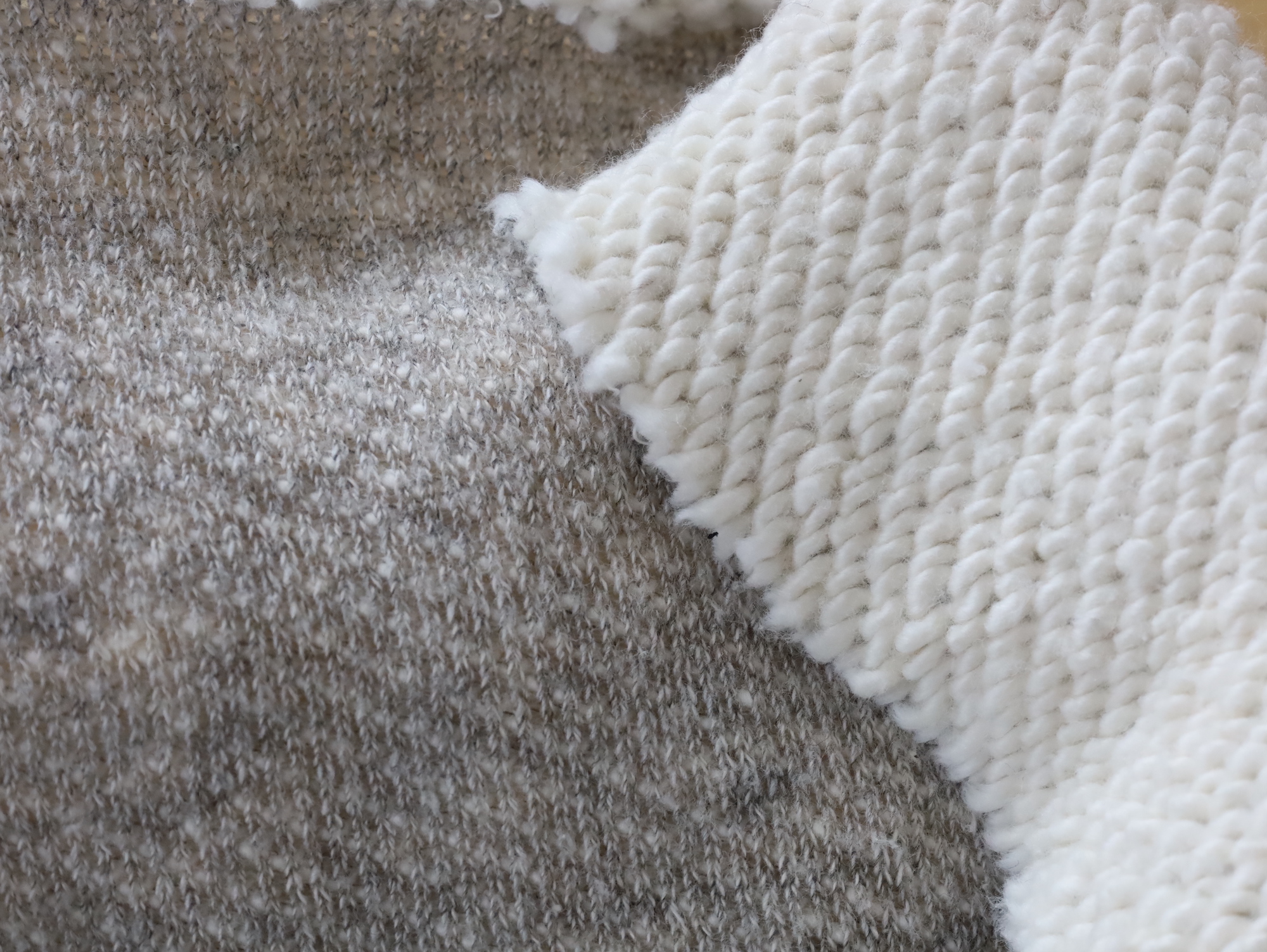
もともと杉原さんは、スウェットは好きではあるが、暑いから春夏には着なかったそうだ。
ただし、そのような素材開発に携わってきていた分、その”暑さ”を取り除くために、肌に当たる裏毛のループを小さくしたミニ裏毛というものなどを着ていたそうだ。
でも、そうなるとどうしても薄くなり過ぎて、ペラペラで頼りないように感じるし、耐久性にも満足いくものを形にすることが難しく、巡り合うこともできなかったそう。
そこで、着目したのが”バスタオル”。
バスタオルは、厚みがあり、包まれるような心地良さと、ホッとする安心感がある。
それにも関わらず、夏でも暑過ぎるとは感じにくいものじゃないですか。
その理論を応用し、まるでバスタオルレベルの心地良さを実現したものがこれ。
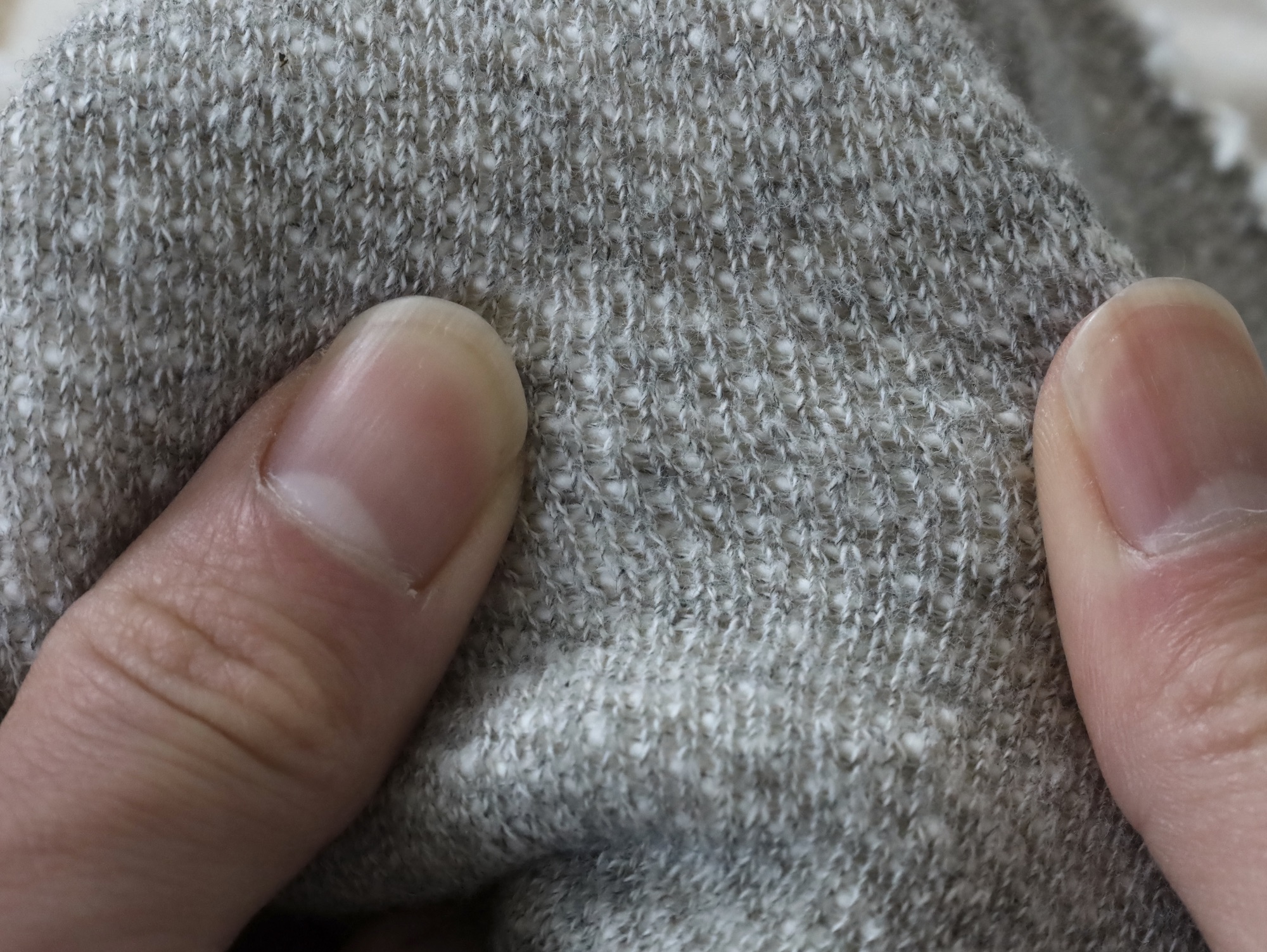
秘密は、その三層構造の糸使いにある。
表と中糸が通常のスウェットと比べても段違いなほどの糸の細さである。
そして、表から白い糸が見えていると思いますが、これが肌に当たる部分、”裏毛”なのだ。

この裏毛は、とてつもなく太い。そして、密集している。
それが表から見えているのだ。
この太い裏毛には、秘密が隠されており、それが着用時の気持ち良さを生み出しているのだが、、、
“無撚糸”というもの。
高級なバスタオルにも採用されている糸で、その名の通り、”糸の撚りが無い”ものである。
極太無撚糸。
ちなみに、無撚糸というものは、最初から撚糸が無いのではなく、最初は少し撚られた単糸(大体Z撚り)に、水溶性(お湯で溶ける)の糸を反対撚りで撚り合わせ、双糸にすることで、単糸の撚りが戻される。
そして、それが生地に編む、または織られた後に、洗い加工によって、水溶性の糸は溶け、撚りがほとんどなくなった”無撚糸”となり、撚りが無い分、フワッとソフトタッチになるわけだ。
(最初の着用だけ繊維が脱落しやすいですが、一度洗濯をして頂くことによって落ち着きます)
これが肌側にあることで、非常に優しい当たりと、無理なく包まれる感覚がある。
しかしながら、先述の通り、表の糸と、つなぎ役の中糸は、細番手であり、自然に風が通り抜ける。
皆様、ご想像下さい。
ふんわりとした上質なバスタオルに身を委ねながら、春や初夏の爽やかな風が通り抜けることを。
明らかに心地良いじゃないですか。
加えて、それは洗濯を繰り返した後でも変わらない。
また、表糸に隙間をつくるために緩く編んでいるのにも関わらず、ノビノビになってしまったり、ダレてしまうことがない。
これは、スウェットには、シンカー編み機というものと、吊り編み機というものがあるのだが、吊り編み機が編むスピードが遅いため、糸の特性を最大に引き出すことができ、丈夫にすることができるために、吊り編み機で編んでいるそうだ。
よく吊り編み機を使っているということだけが謳い文句になるケースはあるが、この素材に杉原さんと一緒に関わっている人物は、つくる生地のゴール地点を定めた上で、最適な編み機をチョイスするこの道のエキスパート。
だからこそ、この生地のクオリティが実現しているのである。

表糸と中糸は、複数色のカラーリングが使われたもの。
だから、一見するとオーセンティックな表情を見せるが、実のところは複雑な様を見せる。
加えて、裏の極太無撚糸がポコポコと顔を覗かせる。
平坦ではない、高級感が漂う生地である。


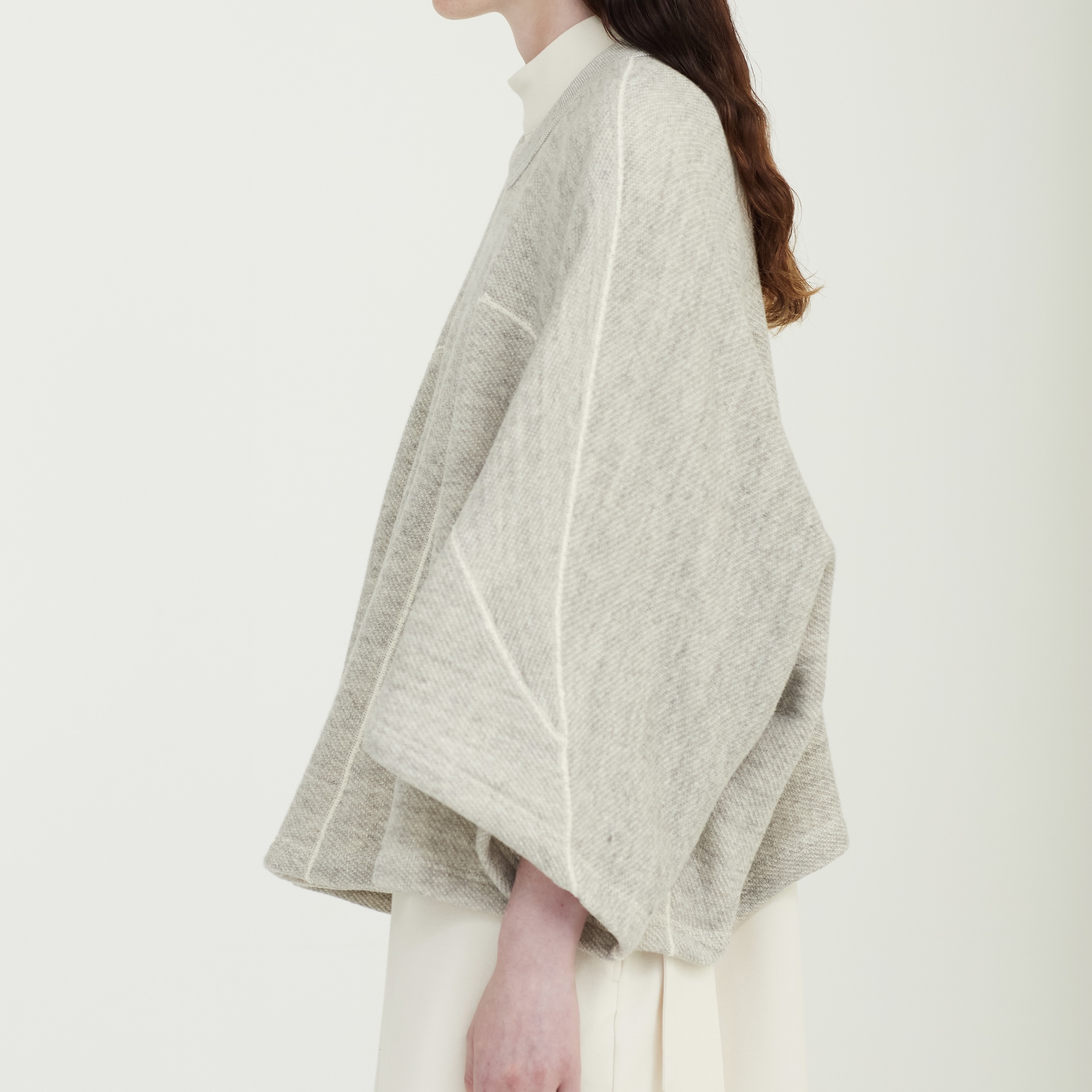
AEHRRのコレクションルックより。
シームは全てが古いユニオンスペシャル社製ミシンによるもので、ものすごく美しい。
これを縫う縫製の方々も、日頃からの縫製技術の研究が凄まじい方々である。
だから、表細番手で緩く編まれた生地は、AEHRRのカーブが多いシームの場合には、縫うだけで局所的に縫い伸びしてしまいやすいが、それが一切ない。
そのため、フォルムはもちろんのこと、構造がとても安定し、この構造のまま着続けることができるようになっている。
そして、次。
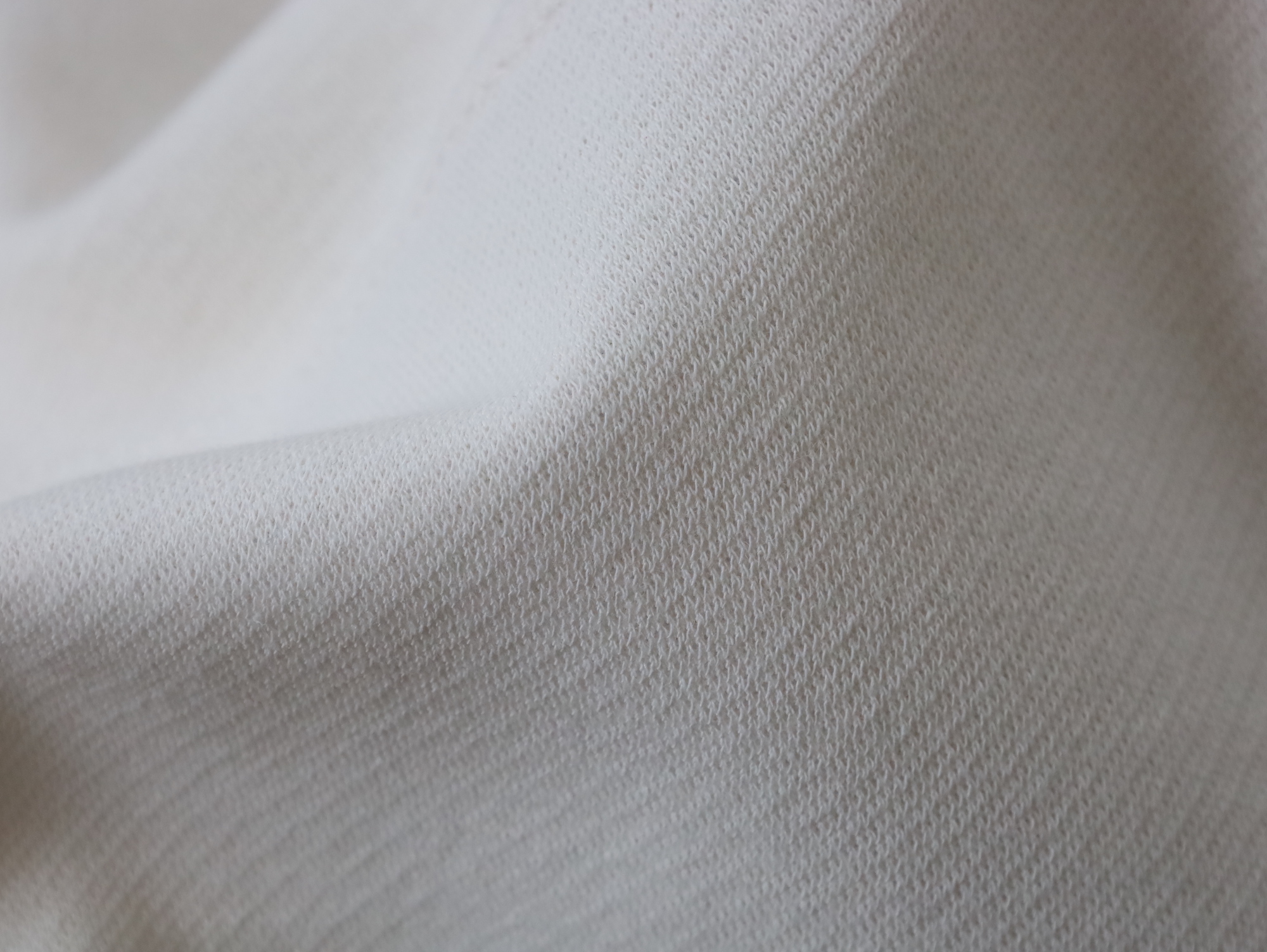
<Twill Ponte Jersey>
この生地の誕生のきっかけは、伸縮性があり身体の動きに追従し、ストレスフリーに着られるジャージーという生地でありながら、
“あたかもキメの細かい布帛のような見え方、表情であること。”
また、
“生地に特有のハリがあることで、薄着の季節でもボディラインを拾いにくく、AEHRRの造形がしっかりと描かれるもの。”
という、ものづくりの上で高いハードルを乗り越えながら、女性の方々に日々好んで着てもらえるように考えられたものである。
素材は、綿100%のジャージー(編み地)でありながらも、綾目(ツイル生地のような)が見える他にない構造の生地である。
この生地は、長年杉原さんと強い信頼関係のある和歌山県の老舗カットソーメーカーで、一緒に開発を行なった編み地。
先述のように、編みで布帛のような綾の見た目、ハリ、柔らかく適度な伸縮性、肌当たり。
これを実現することは、かなり難しいことであるため、デザイナー自身も、絶対に他にはない組織であり、革命的なジャージーであると言っています。
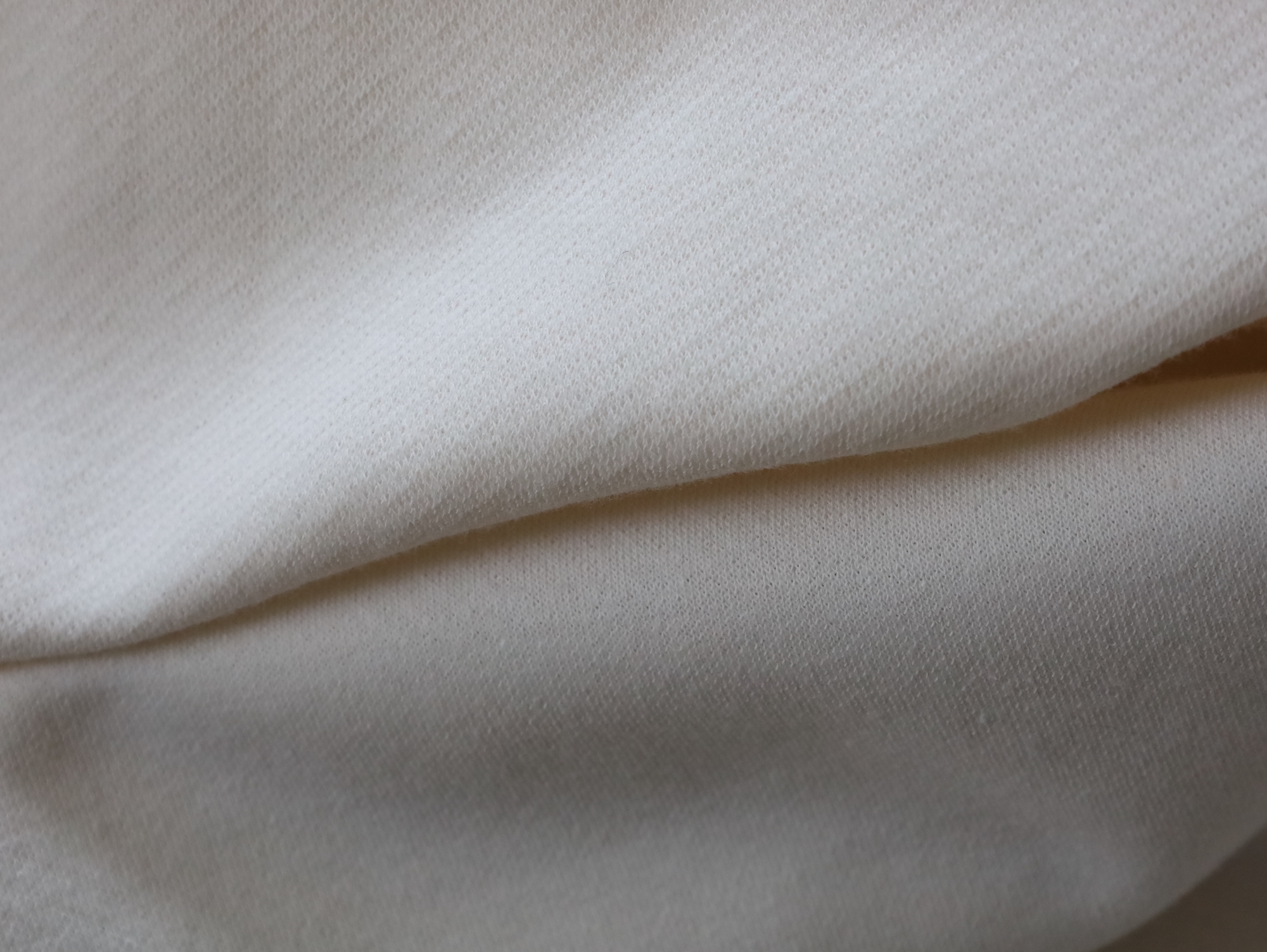
写真中央より上が表側。下側が裏側。
裏は、細い番手の糸。
とても滑らかな当たりである。


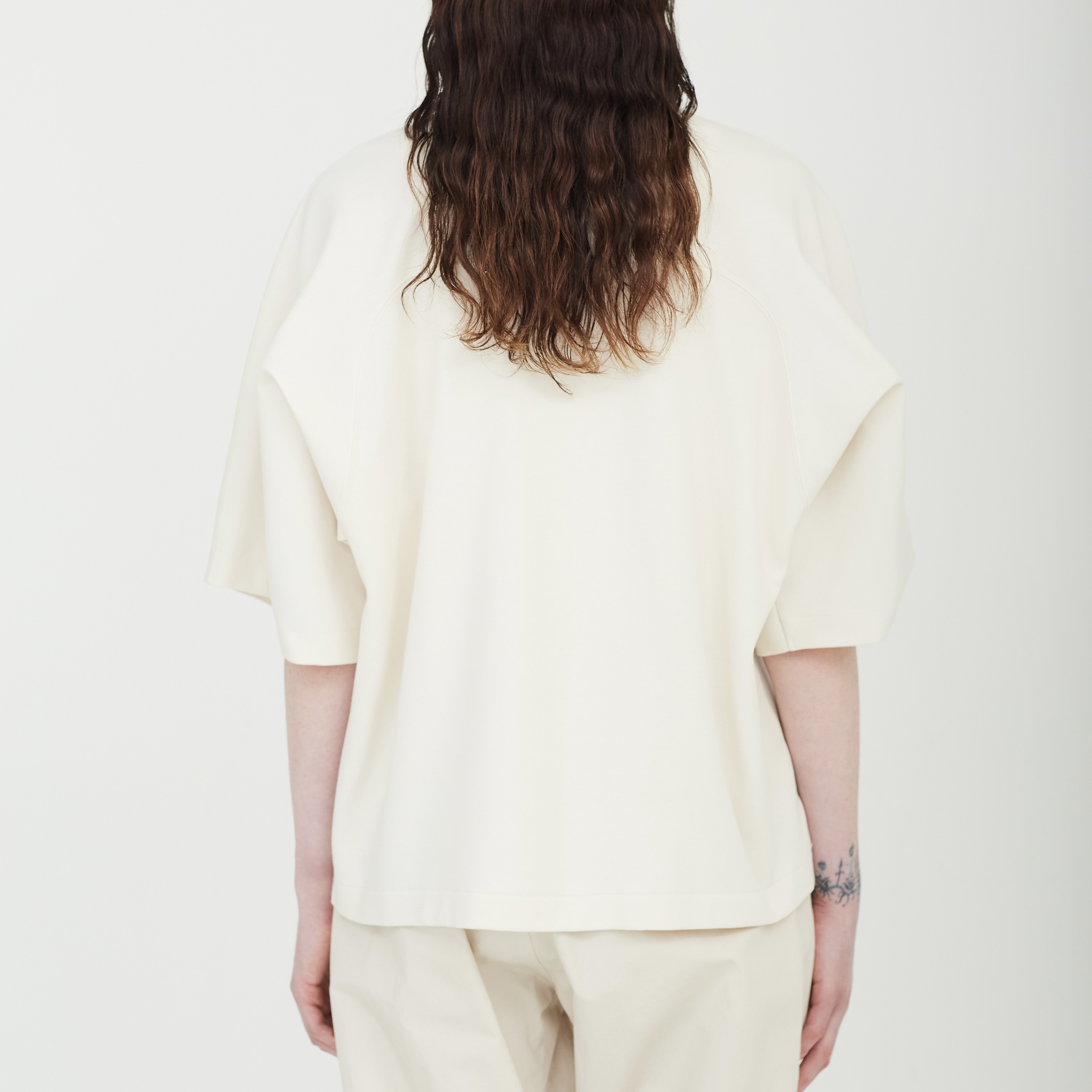
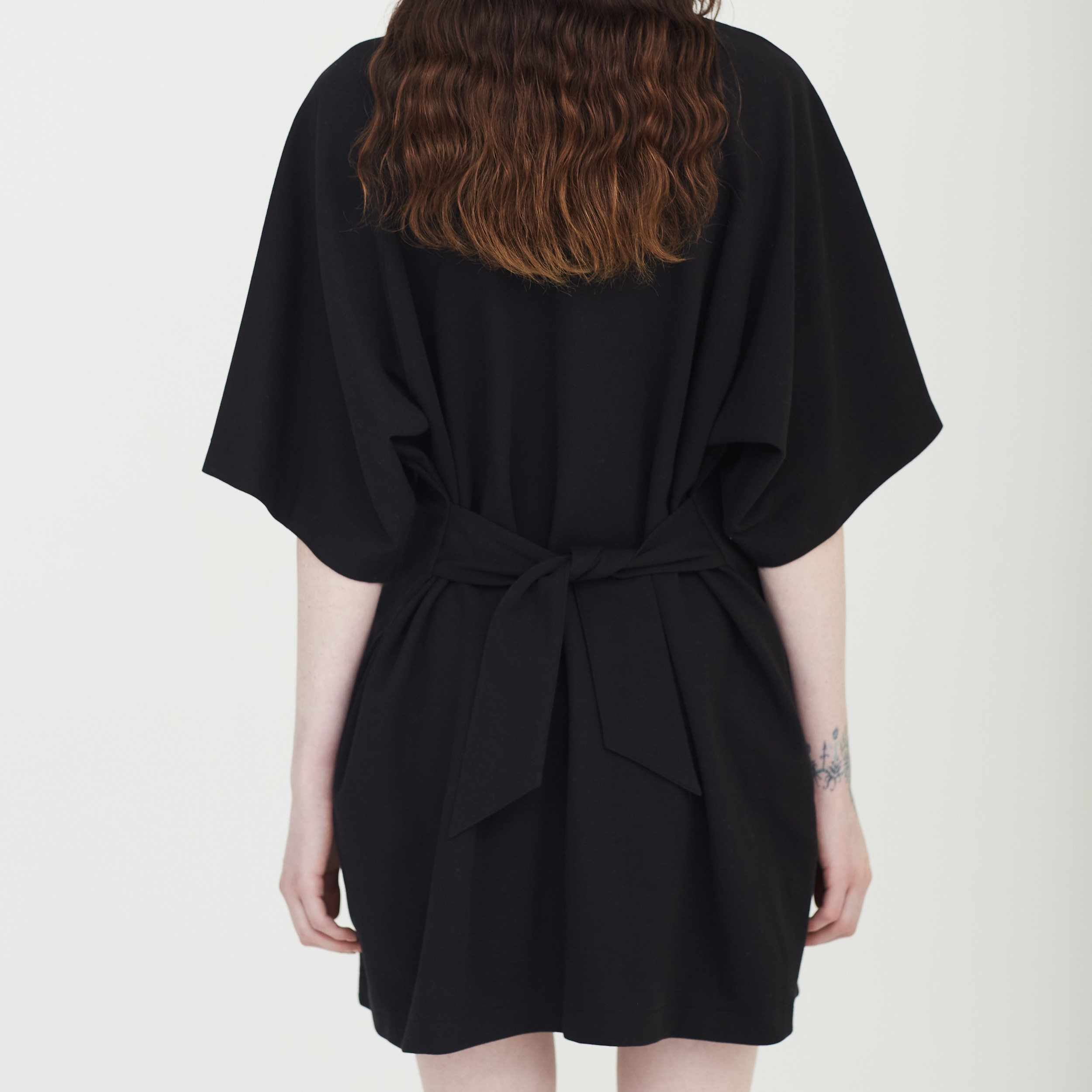
非常に鮮明にアウトラインを描く、Twill Ponte Jerseyの生地を使った洋服。
カットソーにも関わらず、このフォルムのトップスは薄着になる春夏の季節には、とても心強い存在になってくれると思います。
もちろん丈夫であり、春夏の季節には、特に切っても切り離せない家庭洗濯にもとても強い。
AEHRRの洋服の構造については、また後日紹介をさせてもらうつもりですが、このように洗濯に強く、型崩れを起こしにくいし、生地の劣化も全然心配しなくても良い。
春、夏にはすごく気持ち良いから、気兼ねなく着られるし、ボディラインを拾いにくく造形が描かれるから、非常に美しい洋服。
このようなコレクションは、この世界で戦う女性を支えるような、強い味方になってくれるものではないかと思います。
LE BERGER / Herd Limited.
shop talk & communications by Akihiko Fukuda
__________
The English translation is as follows:
Today, we would like to introduce two types of fabrics used in AEHRR’s debut season.
Previously, we introduced the woven cotton fabric “Heavy Broadcloth” made in collaboration with Kaneta Orimono.
<Below is the link to that article>
**AEHRR: “100% Cotton Woven Fabric to Support the Modern Woman”**
This time, we turn to knit fabrics.
These two types of knit fabrics fully showcase AEHRR’s craftsmanship and depth.
As mentioned in a previous blog post, Sugihara-san of AEHRR aspires to be a “form-maker” rather than just a designer.
At the same time, over the course of his career—while refining his draping and construction techniques—he spent nearly 10 years working at a long-established cut-and-sew manufacturer, where he was involved in the development of knit fabrics.
He possesses an exceptionally deep knowledge of jersey and knit materials—understanding not only the varieties of cotton and their spinning and twisting techniques but also how those characteristics can be manipulated and translated into different knit structures for specific purposes.
Beyond the technical exploration of materials, Sugihara-san has also spent years physically experiencing the varying qualities of fabric across all four seasons—continuously building knowledge through hands-on observation, which allows him to push into uncharted territory.
This type of accumulated experience enables him to clearly visualize the final form of a fabric during the development process with textile technicians, helping him determine the best balance with the shapes he creates.
Thus, in this debut season—composed of three original fabrics—one is the previously introduced woven “Heavy Broadcloth.”
What’s particularly noteworthy is that the remaining two fabrics are both knits, which is quite rare in terms of collection balance.
However, this speaks to the uniqueness of Sugihara-san.
Knit fabrics, such as those used in cut-and-sew pieces, often differ from woven fabrics in that their distinctions are less immediately visible or tangible.
Still, these knits go far beyond that.
Not only do they offer a high level of skin comfort and exceptional internal climate control, they are also created with the question in mind:
“To what extent can knitwear enhance the beauty of a woman?”
And furthermore:
“How can clothing become a source of support for women navigating and thriving in this world?”
These are the questions that shaped this collection—designed with profound intent.
Let us introduce them to you, one by one.
<Huge Loopwheel Sweat>
The first piece is this one.
A sweatshirt for the spring/summer season.
This is the result of Sugihara-san combining his own embodied experience and accumulated knowledge with his development expertise—brought to life in collaboration with master fabric technicians and sewing artisans.
To begin with, sweatshirting is a three-layer knit structure.
It is composed of the outer yarn (the visible surface), the inner looped pile (which touches the skin), and the middle yarn that connects the two—forming a triple-layered fabric.
Although the material is elastic, its structure naturally gives it more thickness compared to other fabrics.
Given that sweatshirts are often worn as loungewear, they are generally associated with comfort and ease of movement.
This sweatshirt, however, has been elevated—crafted to be exceptionally comfortable for the spring and summer seasons, while also durable and beautifully refined.
It is a sweatshirt, but one reimagined and executed at a very high level.
Originally, Sugihara-san liked sweatshirts, but found them too warm to wear during the spring and summer seasons.
However, having been involved in textile development, he was familiar with solutions aimed at reducing that heat—such as using mini-loopback fabrics, where the loops on the reverse side of the sweatshirt are made smaller to enhance breathability.
But this approach often resulted in materials that felt too thin and flimsy, lacking a sense of reliability. It was also difficult to achieve the desired durability, and he could never quite find a fabric that met all his expectations.
That’s when he turned his attention to bath towels.
Bath towels are thick, offer a wraparound comfort, and provide a soothing sense of security—yet they don’t feel overwhelmingly hot, even in the summer.
Applying that same logic, Sugihara-san developed a sweatshirt material that mirrors the comfort of a bath towel, creating something that feels both comforting and breathable, even in warmer seasons.
The secret lies in the three-layer yarn construction of the fabric.
Both the outer yarn and the middle yarn are exceptionally fine—far more delicate than those used in conventional sweatshirts.
And if you notice the white yarns visible from the outside, those are actually the loopback threads that sit against the skin—the inner layer of the sweatshirt.
The loopback threads on the inner side of the fabric are incredibly thick—and densely packed.
That plush inner layer is what you’re seeing from the outside.
But the true secret behind its extraordinary comfort lies in the type of yarn used:
“Zero-twist yarn” (Munen-shi)
This yarn is often found in luxury bath towels, and as the name suggests, it is yarn without twist.
However, zero-twist yarns are not untwisted from the beginning. Here’s how they’re made:
A slightly twisted single yarn (usually with a Z-twist) is first combined with a water-soluble yarn twisted in the opposite direction, forming a double-ply.
Once the fabric is knitted or woven and washed, the water-soluble yarn dissolves in warm water, reversing the twist in the original yarn.
The result? A super-soft, fluffy texture with almost no twist remaining.
(Note: The fabric may shed fibers after the first wear, but this settles after washing.)
Placed on the skin side of the garment, this zero-twist yarn provides a gentle, caressing touch and a sensation of effortless embrace.
Meanwhile, as previously mentioned, the outer yarn and connecting yarn are made from fine-gauge yarns, allowing air to flow naturally through the fabric.
Now imagine this:
Wrapping yourself in a plush, luxurious bath towel while a crisp spring breeze gently passes through the fabric.
It’s clearly an experience of pure comfort.
And that comfort doesn’t fade, even after repeated washes.
Despite being loosely knitted to create space between outer threads, the fabric does not lose its shape or become baggy over time.
That’s because this sweatshirt is made using a loopwheel knitting machine (tsuri-ami-ki), rather than the more common sinker knitting machine.
The loopwheel machine knits at an extremely slow pace, which allows each yarn’s potential to fully bloom, enhancing the fabric’s durability and character.
It’s worth noting that simply saying something is made with a loopwheel machine can be a buzzword—but in this case, the expert working alongside Sugihara-san is someone who chooses the machine based on the intended final fabric experience.
That’s exactly why this fabric reaches such an exceptional level of quality.
The outer and middle yarns are composed of multiple colors,
which, at first glance, give the fabric an authentically classic appearance—
but on closer inspection, reveal a complex and layered expression.
Adding to this, the bulky zero-twist yarn from the reverse side subtly peeks through the surface,
creating a tactile texture that’s far from flat.
The result is a fabric with rich dimension and quiet luxury,
imbued with a presence that feels anything but ordinary.
All seams are constructed using vintage Union Special sewing machines, resulting in stitching that is remarkably beautiful.
The artisans behind the sewing are individuals who dedicate themselves daily to the relentless study of sewing techniques, and it truly shows.
Because the fabric is loosely knitted with fine outer yarns, it’s typically vulnerable to localized stretching, especially along the curved seams that are characteristic of AEHRR’s silhouettes.
However, with this level of craftsmanship, there is absolutely none of that distortion.
As a result, not only is the form preserved, but the structural integrity remains incredibly stable—
allowing the garment to maintain its precise shape over time, exactly as it was intended to be worn.
<Twill Ponte Jersey>
The origin of this fabric lies in a desire to create a jersey material that offers stretch and follows the movement of the body for stress-free wear—
yet visually appears as refined and structured as a high-density woven fabric.
Additionally, it was developed to:
- Provide a natural firmness and structure that resists clinging to the body,
- And clearly express AEHRR’s sculptural silhouette, even in the lighter clothing seasons.
Though it is a 100% cotton knit fabric, it features a distinct twill texture, uncommon in traditional jersey materials.
This knit was co-developed with a historic cut-and-sew manufacturer in Wakayama Prefecture, with whom designer Sugihara shares a long-standing relationship built on trust.
As previously noted, achieving a jersey that looks like a woven twill—with body, crispness, softness, and stretch—
requires extraordinary craftsmanship.
Sugihara himself describes this fabric as a truly original structure and a revolutionary jersey, found nowhere else.
Garments crafted from Twill Ponte Jersey, with their sharply defined outlines, demonstrate just how clearly this fabric captures AEHRR’s sculptural silhouette.
Despite being a knit, these tops offer structure and presence, making them incredibly reliable pieces for the spring and summer seasons when lighter layers are worn.
Of course, they are exceptionally durable and well-suited to frequent home washing, which becomes even more important during warmer months.
While the structural approach behind AEHRR’s garments will be shared in more detail at a later time, it’s worth noting now that this material:
- Holds its shape,
- Resists deformation,
- And retains quality over time, with minimal concern for wear.
It’s the kind of clothing that feels good on the skin in spring and summer, can be worn freely and comfortably, and—most importantly—doesn’t cling to the body, allowing for graceful form and movement.
Collections like this, I believe, become a powerful ally for women who navigate and challenge the world daily.
